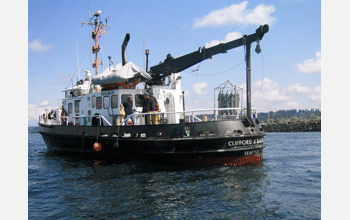Multimedia Gallery
R/V Clifford A. Barnes
The R/V Clifford A. Barnes during a research cruise to Edmonds, Wash. During the cruise, a research team from the University of Washington's School of Oceanography recorded data that will be used to form a baseline for researchers in the future to determine (quantitatively) whether the sewage outfall from a new wastewater treatment plant is effecting the local marine environment. The new treatment plant, called Brightwater, is being constructed in King County, Wash., and is expected to begin operating in 2011.
Among the equipment used to gather data was a CTD (conductivity, temperature and density) Rosette, a 500-pound collection of sensors and water sample bottles that can measure such things as conductivity (determines salinity), light transmission (determines the amount of particles in the water), fluorescence (determines the amount of chlorophyll, such as phytoplankton, in the water), temperature, depth, distance from the bottom, and visible light from the surface. Researchers watch profiles of the data in real-time as the CTD is lowered, then use the information to figure out where to take water samples on the way back up. In addition, sediment samples were taken from the bottom to reveal the biomass (usually flatworms) and plankton nets were used to sample the local phytoplankton and zooplankton.
The R/V Clifford A. Barnes is owned by the National Science Foundation and operated under a charter party agreement by the School of Oceanography at the University of Washington as part of the UNOLS (University-National Oceanographic Laboratory System) fleet. It is intended for use primarily in the sheltered waters of Western Washington and British Columbia. (Date of Image: May 2006)
Credit: Amanda Gray, University of Washington School of Oceanography
Images and other media in the National Science Foundation Multimedia Gallery are available for use in print and electronic material by NSF employees, members of the media, university staff, teachers and the general public. All media in the gallery are intended for personal, educational and nonprofit/non-commercial use only.
Images credited to the National Science Foundation, a federal agency, are in the public domain. The images were created by employees of the United States Government as part of their official duties or prepared by contractors as "works for hire" for NSF. You may freely use NSF-credited images and, at your discretion, credit NSF with a "Courtesy: National Science Foundation" notation.
Additional information about general usage can be found in Conditions.
Also Available:
Download the high-resolution JPG version of the image. (473 KB)
Use your mouse to right-click (Mac users may need to Ctrl-click) the link above and choose the option that will save the file or target to your computer.

